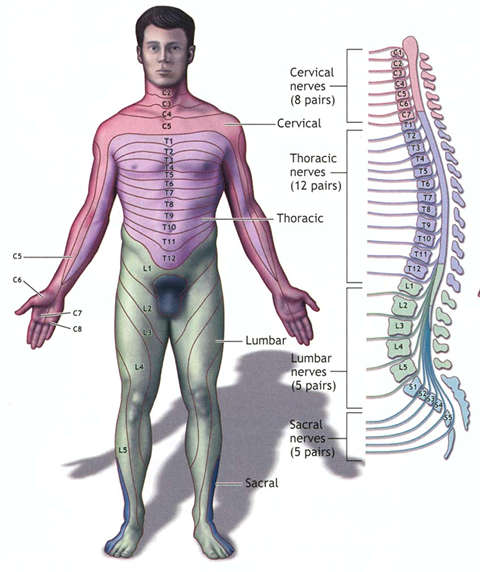In the past few blogs, I’ve been discussing both disc herniation and Degenerative Disc Disease in the lower spine. This week, I want to talk a little bit about how these occurrences affect the middle back, or Thoracic spine.
“The most common location for thoracic disc disorders is at the thoracolumbar (the thoracic and lumbar parts of the spinal column) junction (T8-T12) in the mid back. The true incidence is unknown because many thoracic disc disorders do not cause thoracic back pain or other symptoms.” – Spine-Health.com
In the diagram below, the purple area represents the areas of the body that are controlled by the Thoracic nerves.

Image via Journal of Young Investigators
As you can see, these nerves affect the chest and abdominal muscles. Consequently, one of the most common symptoms associated with a Thoracic herniated disc is pain radiating from the back and perceived in the chest or belly. This pain may be exacerbated when coughing or sneezing. If you are experiencing these types of symptoms, it is very important to make sure you are able to rule out other causes, such as disorders of the heart, lung, kidney and gastrointestinal systems. If you are experiencing numbness, lower extremity weakness, or bowel/bladder dysfunction, you may be presenting with myelopathy, or spinal cord dysfunction, which can happen if the disc herniates into the spinal cord area. Myelopathy is most likely to be caused by central or centro-lateral disc protrusions (meaning those that press into the middle of the spine. Lateral protrusions (or those that press to the side and onto the exiting nerve roots) are more likely to be the culprit of chest and abdominal pain. Generally, an MRI is used to identify the root cause of the pain. Treatments for Thoracic disc herniation includes manual chiropractic manipulation, strengthening exercises and spinal decompression. As I mentioned previously, spinal decompression allows vital nutrients to re-enter the damaged disc so that it can repair itself. In addition, there are spinal decompression exercises that one can perform, but I would only recommend these exercises on a case by case basis depending on your specific needs. * Find out more about these decompression exercises.
In next week’s blog, I’ll be exploring the role of posture in Thoracic disc bulges.
Dr. Bart
